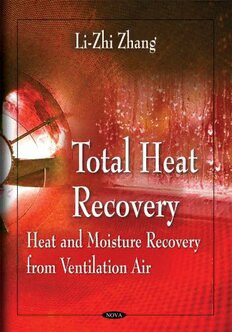
Total Heat Recovery: Heat and Moisture Recovery from Ventilation Air PDF
327 Pages·2008·5.563 MB·English
Most books are stored in the elastic cloud where traffic is expensive. For this reason, we have a limit on daily download.
Preview Total Heat Recovery: Heat and Moisture Recovery from Ventilation Air
Description:
Energy has been described as 'that which makes things go'. Air conditioning accounts for 1/3 of the total energy use in society. Further, ventilation air accounts for 20-40 percent of the cooling load for HVAC (Heating, ventilating, and Air conditioning) industry. The ratio can be even higher in hot and humid regions where latent load from fresh air is as heavy as 50 percent of the cooling load. In this book, the systems and performances used for total heat recovery are introduced. They can be classified into two categories: energy wheels and stationary total heat exchangers. Energy wheels and membrane based total heat exchangers are specially described. Heat and mass transfer modelling of the system are performed. Influences of key material and design parameters on the system performance are discussed. Novel membranes including hydrophobic-hydrophilic composite membrane and composite supported liquid membrane are developed for total heat exchangers and are characterised. Sorption and diffusion of moisture in hygroscopic materials are the key parameters influencing latent heat recovery capability. Their appraisal methods are provided and implemented. Besides materials side intensification, air side intensification measures are taken as well. Plate-fin and cross corrugated triangular ducts are two important structures that are introduced. Plate-fin is compact and mechanically strong. Cross-corrugated triangular ducts are a new type of primary surface heat mass exchanger. The basic transport data in these structures are provided. Convective heat and mass transfer coefficients in plate-fin ducts of finite fin conductance with various cross sections are numerical obtained. Fluid flow and heat transfer in cross-corrugated triangular ducts are estimated by considering laminar, transitional, and turbulent complex flow regimes. Based on the fundamental heat mass transfer data, the book illustrates some examples of the applications of total heat recovery in novel HVAC systems. Chilled-ceiling combined with desiccant cooling and independent air dehumidification are two pioneering trends in air conditioning industry. They overcome the shortcomings of conventional all air systems by decoupling the treatment of sensible load with latent load. Partial or full total heat recovery are realised in combination with these novel systems, which contribute to reduced energy use with increased indoor humidity control, even in transit seasons when traditional air conditioning systems fail to control humidity. The component modelling of various key equipments like refrigeration cycle, heat pumps, regenerative wheels, heat exchangers, cooling coils, are conducted to estimate their energy performance and their effects on indoor thermal and humidity performance. The book combines theoretical analysis with engineering practices. It covers a wide range of knowledge from fundamental heat mass transfer data to novel systems design and performance analysis, from materials synthesis, characterisation to thermodynamics and fluid dynamics. As a kernel part, numerical heat mass transfer provides the tool for component modelling. The book provides crucial insight and design guidelines for the total heat recovery focused air conditioning industry.
See more
The list of books you might like
Most books are stored in the elastic cloud where traffic is expensive. For this reason, we have a limit on daily download.
